In September 2019, Greta Thunberg, a sixteen-year-old Swedish climate change activist, gave an impassioned speech to hundreds of world leaders at the United Nations calling for action to mitigate climate change: “For more than [thirty] years,” she exclaimed, “The science has been crystal clear. How dare you continue to look away” (Weise Reference Weise2019, para. 7). As Thunberg asserted, we have known about the dangers of human impact on the environment for decades. Unfortunately, politics impedes action against climate change, providing a cover used by conservative leaders to subvert climate mitigation policies. Climate change contrariansFootnote 1 play a critical role in perpetuating this cover by keeping the debate about climate change alive in the political and public arenas—even though it is settled in the scientific realm.
Though few in number, 3 per cent of climate scientists and peer-reviewed climate science papers reject the consensus not only that is climate change occurring, but also that it is happening as a result of human activity (Anderegg et al. Reference Anderegg2010; Cook et al. Reference Cook2013; Cook et al. Reference Cook2016; Doran and Zimmerman Reference Doran and Zimmerman2009; Pew Research Center 2015). These individuals and publications play a role in progressing the climate change countermovement and allow leaders to point to them as evidence to justify inaction (Boykoff Reference Boykoff2011; McCright and Dunlap Reference McCright and Dunlap2011a; McKewon Reference McKewon2012). Such efforts are just one way “conservative think tanks, advocacy groups, trade associations and conservative foundations, with strong links to sympathetic media outlets and conservative politicians” work to subvert the mainstream climate consensus (Brulle Reference Brulle2014, 692).
Climate change is a critical issue that must be addressed by policy makers (IPCC 2020). Therefore, understanding who is responsible for fueling the debate regarding climate change, as well as why they continue to push contrarian viewpoints, is important if leaders are to overcome the obstacles posed by these individuals. Others have documented the people and publications that make up the 3 per cent, as well as the intricate web of the climate change countermovement with which they are connected; however, we seek not only to broaden understanding of who makes up this small cohort of experts, but also to understand similarities between experts and non-experts who share the same views.
Before providing an overview of the individuals compiled in the data, we briefly discuss the history of the climate change science debate. Following analysis of the data, we discuss potential reasons why these individuals may hold contrarian views, for example, events, experiences, and ideological attitudes of certain periods that may influence attitudes toward science and/or government. Importantly, we find support for prior research that calls into question the ability of the 3 per cent to render an expert opinion on the causes and implications of climate change.
Background
Although it is hard to pinpoint when climate science first emerged, it was in 1822 that Jean-Baptiste Joseph Fourier suggested that the Earth is insulated by its atmosphere. Eunice Foote in 1856, as well as John Tyndall in 1859, reported findings on how specific elements (that is, water vapor and carbon dioxide) absorb heat, providing the foundation for what would later be known as the greenhouse effect.Footnote 2 At the turn of the 20th century, Svante Arrhenius made the first argument that human CO2 emissions would prevent earth from entering the next ice age. On August 14, 1912, in what is believed to be the first newspaper to report on climate change and its link to fossil fuels, the Rodney and Otamatea Times printed a brief paragraph in the “science notes and news” section which “warned that the Earth's atmosphere was changing because of … [increased] production of fossil fuels” (Brueck Reference Brueck2018, paras 2–3). Despite these early indicators, little attention was paid to these findings. In fact, it would not be until the 1950s that the human impact on the atmosphere slowly began to shift into the mainstream focus.
The 1950s and 1960s saw advancement in space exploration, and with it came a greater understanding of Earth and its atmosphere. Climate change research also began to flourish, with organizations such as the International Global Atmospheric Research Program established to further scientific understanding of weather patterns and climate change. By the end of the 1970s, the scientific community was largely in consensus that global warming was the main environmental risk facing the next century. Unfortunately, just as scientific consensus emerged, so too did political backlash and the rise of neoliberal ideology (Weart Reference Weart2008). With the changing political climate came an increased effort to challenge the forming scientific consensus regarding the cause and impact of climate change.
Despite political and ideological pushback, the scientific community continued to build upon its knowledge of climate change, reaching near-unanimous consensus on its cause. Naomi Oreskes (Reference Oreskes2004), for example, found that among 928 abstracts of peer-reviewed papers on anthropogenic global warming (AGW) published between 1993 and 2003, none disagreed with the consensus position on climate change. Doran and Zimmerman (Reference Doran and Zimmerman2009, 23) conducted a survey of Earth scientists and determined: “The debate on the authenticity of global warming and the role played by human activity is largely nonexistent among those who understand the nuances and scientific basis of long-term climate processes.” Moreover, they found “the most specialized and knowledgeable respondents (with regard to climate change)” to be the ones who acknowledge overwhelmingly (at a rate of 96.2 per cent) not only that climate change is occurring, but also that it is happening as a result of human activity (Doran and Zimmerman Reference Doran and Zimmerman2009, 23). Anderegg et al. (Reference Anderegg2010) evaluated peer-reviewed climate science papers and multi-signatory documents to find 97 to 98 per cent of top climate researchers agree with the consensus; Cook et al. (Reference Cook2013) also found consensus among climate science papers published between 1991 and 2011. Specifically, following analysis of ≈12,000 abstracts and ≈1,200 self-ratings from peer-reviewed climate science papers, Cook et al. found that of those that stated a position on AGW, 97 per cent endorsed the consensus that climate change is real and a result of human activity. Furthermore, of the 3 per cent of papers that expressed a position on AGW but did not endorse the consensus, 2 per cent rejected the consensus on AGW and 1 per cent was undecided. In addition, more than 66 per cent of abstracts stated no explicit position on AGW, suggesting that “the fundamental science of AGW is no longer controversial among the publishing science community and the remaining debate in the field has moved to other topics” (Cook et al. Reference Cook2013, 4).
Nevertheless, pushback continued, even within the research realm. Peiser (Reference Peiser2005), for example, criticized Oreskes's work for bias. Specifically, Peiser accused Oreskes of ignoring articles contrary to mainstream opinion. As Oreskes pointed out, however, Peiser's rejection of the study was itself flawed since most of the thirty-four articles Peiser listed upheld the mainstream consensus, with the remaining articles lacking credibility.Footnote 3 Peiser ultimately recanted his criticisms, further reinforcing scientific consensus regarding climate change (Beck Reference Beck2006). Doran and Zimmerman's research was also met with criticism over its sampling methods, sample size, and wording of questions; critics also claim the study is too narrow regarding who the authors consider an expert (Idso, Carter, and Singer Reference Idso, Carter and Singer2015). Cook et al.'s research was scrutinized for sampling bias and for its methods, too (Tol Reference Tol2016). Nevertheless, continued research supports their findings and consistently shows “agreement on AGW is overwhelmingly high because the supporting evidence is overwhelmingly strong” (Cook et al. Reference Cook2016, para. 23).
Moreover, the 2 per cent of peer-reviewed papers that reject AGW actually provide additional evidence in favor of the climate change consensus (Benestad et al. Reference Benestad2016). Closer examination of thirty-eight papers that refute the 97 per cent consensus reveals all to have flaws rendering their conclusions invalid. The main errors identified were all related to the way the authors tested the data. As Dana Nuccitelli (Reference Nuccitelli2015, para. 10) describes: “the 2–3 per cent of papers that reject that consensus are all over the map, even contradicting each other. The one thing they seem to have in common is methodological flaws like cherry picking, curve fitting, ignoring inconvenient data, and disregarding known physics.” Additionally, co-author Katharine Hayhoe found: “Every single one of those analyses had an error—in their assumptions, methodology, or analysis—that, when corrected, brought their results into line with the scientific consensus” (Foley Reference Foley2017, para. 5).
Several authors of flawed anti-consensus papers also authored books on the same topic (Dunlap and Jacques Reference Dunlap and Jacques2013). Like the articles, Dunlap and Jacques asserted, these books help bolster claims that reject the climate change consensus. Of all books evaluated, the majority were linked to conservative think tanks; most were also affiliated with conservative ideology. These connections help illustrate the “the strong link between conservatism and promotion of climate change denial” (Dunlap and Jacques Reference Dunlap and Jacques2013, 707; see also Jacques et al. Reference Jacques2008; McCright and Dunlap Reference McCright and Dunlap2011a; McCright et al. Reference McCright2016). The link between these publications and conservative think tanks/ideology is important since the “climate change counter-movement (CCCM)” is rooted in conservative (and, subsequently, conservative think-tank) efforts (Brulle Reference Brulle2014, 682). The CCCM's progress, however, requires significant corporate funding, political support, and magnification via the media and others who serve to profit from their efforts (Brulle Reference Brulle2014). In other words, while only a small number of expert scientists reject climate change consensus, there is a much more complex web of individuals and organizations that make up, and work to promote, contrarian efforts that use these expert and non-expert rejections to bolster their claims.
Unfortunately, the misleading publications, coupled with a lack of a cohesive alternative theory and the efforts of the CCCM, also leads to confusion among the public. In the United States, for example, only 33 per cent of Americans believe scientists fully understand whether climate change is happening; even fewer (28 per cent) believe scientists understand its cause (Pew Research Center 2016). While raising awareness of the agreement among the 97 per cent of experts positively impacts the public's views on climate change, the CCCM serves to keep contrarian arguments in competition with the mainstream consensus; they also fuel the political debate as to whether policies that mitigate climate change are necessary (McCright et al. Reference McCright2013; Rahmstorf Reference Rahmstorf2012; van der Linden et al. Reference Van der Linden2015). As politicians use contrarian arguments as a reason to justify inaction against climate change, it is important not only to understand who these contrarians are, but also to establish what links, if any, they have to organizations and industries that work tirelessly to prevent climate mitigation efforts. Exploring these connections may help explain why these individuals continue to argue against the climate science consensus.
Methods
Prior studies focus primarily on confirming the 97 per cent consensus among expert scientists. Other research explores publications and/or the intricate web of CCCM organizations (Anderegg et al. Reference Anderegg2010; Brulle Reference Brulle2014; Cook et al. Reference Cook2013; Cook et al. Reference Cook2016; Doran and Zimmerman Reference Doran and Zimmerman2009). To the authors' knowledge, no study has utilized multi-signatory documents that reject the climate consensus to evaluate expert and non-expert contrarians beyond publications and through the same countermovement lens. Including these non-experts in our profile is important, especially since those who object to the 97 per cent consensus often point to these multi-signatory documents as further evidence to reject AGW (Boykoff Reference Boykoff2011; McCright and Dunlap Reference McCright and Dunlap2011a; McKewon Reference McKewon2012). As a result, and because many of these documents were open to (or remain open to) signatures from anyone who wishes to participate, we can look for commonalities among experts and non-experts alike—specifically, whether individuals from both groups are tied to the entities who work to subvert the mainstream climate consensus.
Many declarations that reject the climate change consensus are publicly available. To compile a list of individuals for this article, names were drawn from the Bali Open Letter, Manhattan Declaration, Paris Climate Challenge, Lindzen Petition, and Climate Scientists' Register. These documents serve as an official challenge to the global climate discussion and often target specific global policy initiatives. The Paris Climate Challenge 2015, for example, was contrarians' response to COP21 (that is, the 2015 United Nations Climate Change Conference), at which they aimed to “challenge the climate ‘consensus’ … with alternative climate hypotheses” (PCC15 2015, para. 2). The Lindzen Petition also challenged the United Nations Framework Convention on Climate Change (UNFCCC) in 2017 and stated: “carbon dioxide, the target of the UNFCCC is not a pollutant but a major benefit to agriculture and other life on Earth” (Lindzen Reference Lindzen2017, para. 1). Others, like that of the International Climate Science Coalition (ICSC), are not a response to a specific policy or initiative, but allow individuals to endorse statements such as: “The relevant scientific evidence [does] not find convincing support for the hypothesis that human emissions of carbon dioxide are causing … dangerous global warming” (ICSC 2015, para. 1). Although they may have different objectives, the documents serve as official and standing means to voice opposition to the scientific consensus on climate change.
Table 1 provides descriptive information for each multi-signatory document included in the data set. After eliminating signatures that appeared on more than one document, our dataset included 427 individuals. For each of the 427 individuals, we analyzed a variety of variables to gain a better picture of their academic and professional background. Variables include, but are not limited to, their highest level of degree, the subject matter of their awarded degree, their publication record, and professional affiliations connected to special interest and industry organizations. Specifically, we investigated links to organizations/industries identified in prior research as tied to the CCCM (Björnberg et al. Reference Björnberg2017; Brulle Reference Brulle2014; Dunlap and Jacques Reference Dunlap and Jacques2013; McCright and Dunlap Reference McCright and Dunlap2011a; McCright et al. Reference McCright2016; Oreskes and Conway Reference Oreskes and Conway2010; Plehwe Reference Plehwe2014). Although we did not include all previously identified organizations/industries as variables, we included those that appeared the most frequently among contrarians in our data, as well as those that represent individuals with no other known ties.
Table 1. Multi-signatory documents

Notes: a These documents are still open for signatures. For each document's objectives and complete list of signatories, see Bali Open Letter (2007), Lindzen (Reference Lindzen2017), ICSC (2008), ICSC (no date) and PCC15 (2015).
To create a list of climate-specific publication records, we searched for peer-reviewed articles via Google Scholar (search term: “author:fi-lastname climate”). In the event that search results yielded no publications or appeared to reflect multiple authors, we used additional search terms to verify results (“author:firstname-lastname climate”; “author:fi-mi-lastname climate”). We excluded results that were books, articles not affiliated with a peer-reviewed journal, correspondence published in response to peer-reviewed articles, reviews published in peer-reviewed articles, conference abstracts, repository material, duplicate results, or material not related to natural science.
We included personal variables, such as gender, date of birth, and religious affiliation. We obtained any information not included in multi-signatory document profiles from public online sources (for example, university profiles, personal/professional websites, biographies, interviews, publications, and documents archived on websites like desmog.com, skepticalscience.com, and exxonsecrets.com). Care was taken to make certain that information is accurate using intercoder reliability.Footnote 4 We marked any information not found or not verifiable from credible sources as “unknown” and coded it as such.
To determine which individuals in our list are climate experts, we applied criteria used by Anderegg et al. (Reference Anderegg2010), which set a minimum of 20 climate-related, peer-reviewed publications as the base to establish expertise. To also establish which individuals in our data, if any, were the same contrarians identified in previous studies, we collected data from flawed peer-reviewed papers, published contrarian books, and journals that published abstracts that implicitly or explicitly rejected the climate consensus (Benestad et al. Reference Benestad2016; Cook et al. Reference Cook2013; Dunlap and Jacques Reference Dunlap and Jacques2013).
Results
As our aim is to create a profile and look for commonalities among individuals who all share contrarian views, we relied on descriptive statistics to analyze the data. Except for unique identifiers (that is, name, birth year, degree information, and publication information), we coded all raw data as ordinal or interval to determine total counts, means, and percentiles. Table 2 provides a complete list of variables included in the dataset, as well as other descriptive statistics.
Table 2. Descriptive statistics
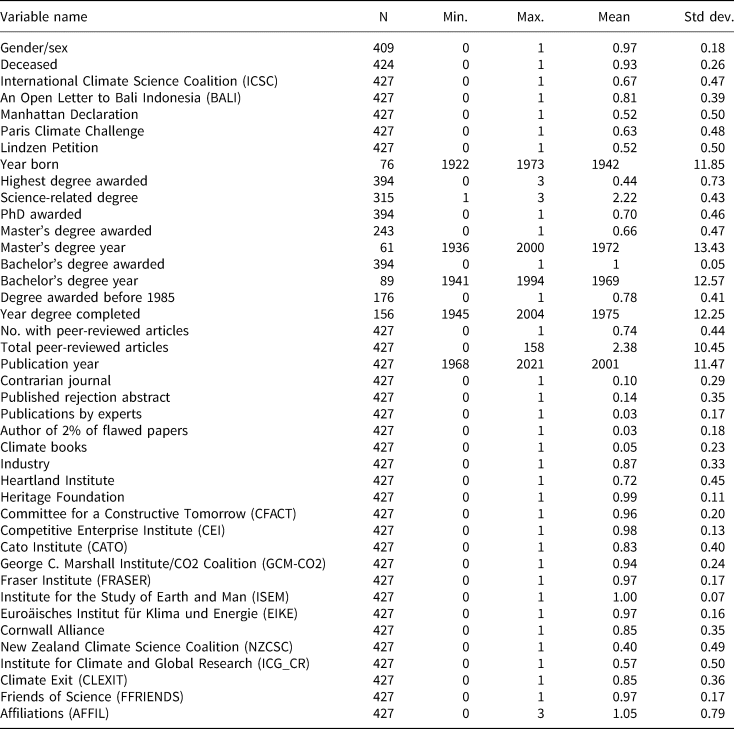
Demographics
A total of 93 per cent of the climate change contrarians on the list were male. This under-representation is not surprising given that fewer women work in the science, technology, engineering, and mathematics (STEM) fields (Nimmesgern Reference Nimmesgern2016). In the United States, for example, the STEM workforce is composed of 27 per cent women and 73 per cent men (Martinez and Christnacht Reference Martinez and Christnacht2021). Importantly, this finding is also consistent with research which found that climate contrarians are more likely to be male compared to the average scientist in general (McCright and Dunlap Reference McCright and Dunlap2011b).
Individuals in the sample were born between 1922 and 1973, with 1942 as the average birth year (std dev. = 11.85). As a result, 87 per cent of individuals on the list (for which data were available) were born prior to 1957, making most contrarians sixty-five years of age or older. The results suggest that scientists born in the 1960s or later are much less likely to oppose the consensus on climate change, or at least less likely to endorse these documents. This information was difficult to locate and contains only 76 observations. As Table 3 shows, though, the results are consistent with the data (of which there were more observations) regarding the year contrarians earned their degree. These results show 81 per cent of climate change contrarians received their degree in 1985 or prior, with 1970 as the year with the highest number of individuals receiving a degree.
Table 3. Frequencies—year born versus year degree completed

In addition to contrarians' generally advanced age, twenty-seven individuals on the list were deceased at the time of the documents' alleged endorsement. Although no justification is apparent, it is possible that authors copied names from existing declarations to newly drafted documents without knowledge or permission.
Education and Professional Experience
A total of 81 per cent of the climate change contrarians received their highest level of college degree (that is, Bachelor's, Master's, PhD, or level of degree relative to institution, location, and/or area of study) in 1985 or prior.Footnote 5 The most common time when contrarians received their degrees was the 1970s.Footnote 6 This suggests individuals receiving their degrees within the last thirty years are less likely to reject the climate change consensus. This pattern could be for several reasons, for example: new modeling or other scientific revelations not known at the time climate change contrarians received their degree; changes in how certain areas (for example, meteorology) approach research; or, as we suggest later, the impact of conservatism/neoliberalism on views of science and/or government (see Figure 1).
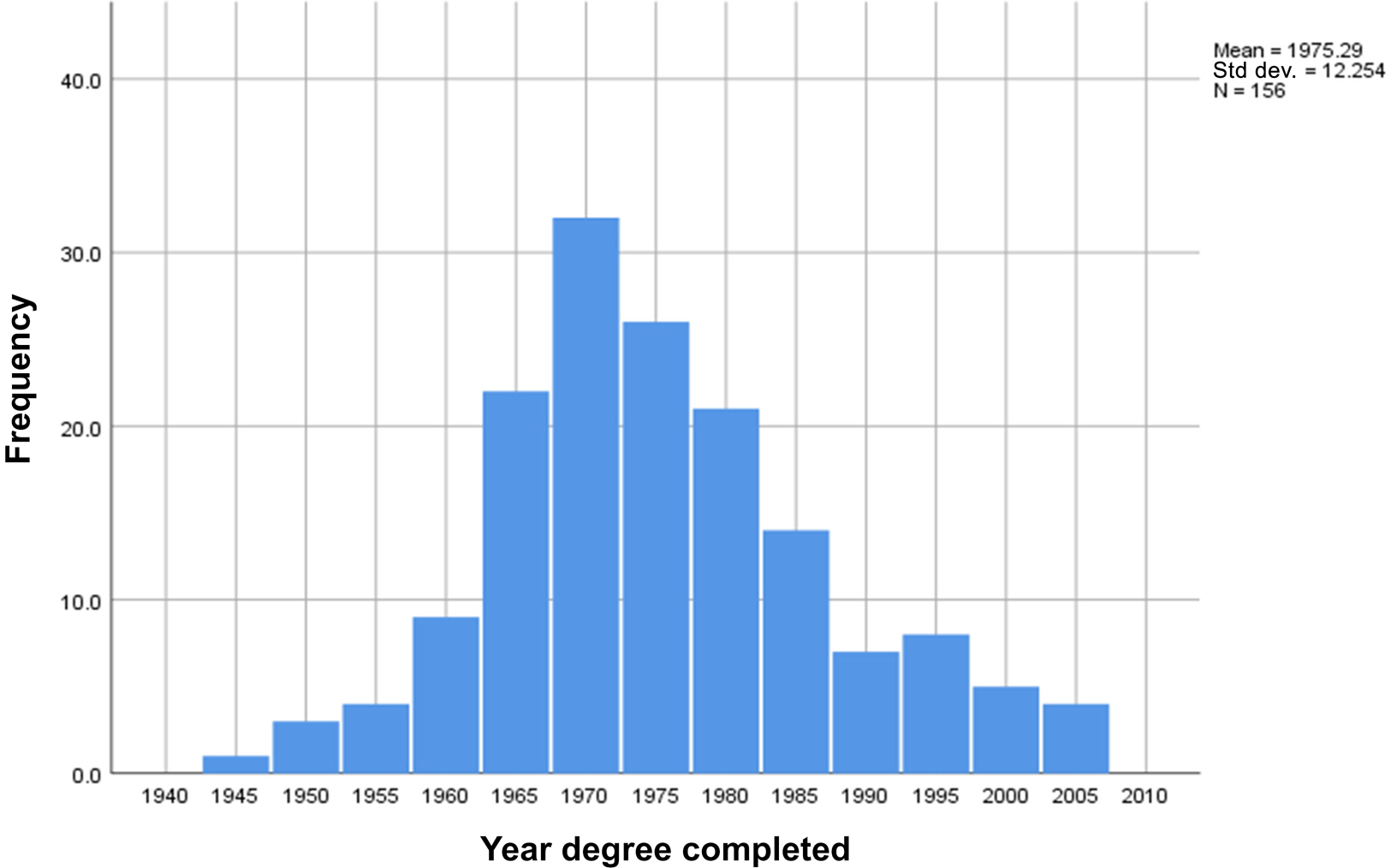
Figure. 1. Year contrarians completed highest degree.
Almost none of the individuals who signed the documents have a degree directly related to climate science. In fact, less than 1 per cent of the individuals in the sample have a degree deemed relevant to climate science, with relevance defined as individuals having a degree in climatology or a similar field. A total of 77 per cent of contrarians, however, have a scientific degree that could provide some knowledge related to climatology, for example, physics, geography, or engineering. Just under 23 per cent of contrarians have a degree with no direct relation to science, for example, statistics, economics, international relations, and those related to the humanities.Footnote 7
Interestingly, physics is the most common degree (2.4 per cent) to appear in our sample. This finding is consistent with prior research which established that contrarian scientists “tend to be empiricists and physicists (i.e., theoreticians)” (Lahsen Reference Lahsen2013, 748). Degrees in geological sciences were the second-largest group at 2.2 per cent. While these degrees represent a broad area of Earth sciences, many that appear in our data (for example, engineering, mining, and geology) are particularly desired by the fossil fuel industry (Allison and Mandler Reference Allison and Mandler2018; NRC 2013). Conservative think tanks also heavily target TV weather forecasters and meteorologists, who make up 1 per cent of degrees in our sample, and who may also be prone to contrarian views because of their “stance with political and socio-cultural factors” (Björnberg et al. Reference Björnberg2017, 235; see also Homans Reference Homans2010; Lahsen Reference Lahsen2013) (see Table 4).
Table 4. Total contrarians in specific degree areas
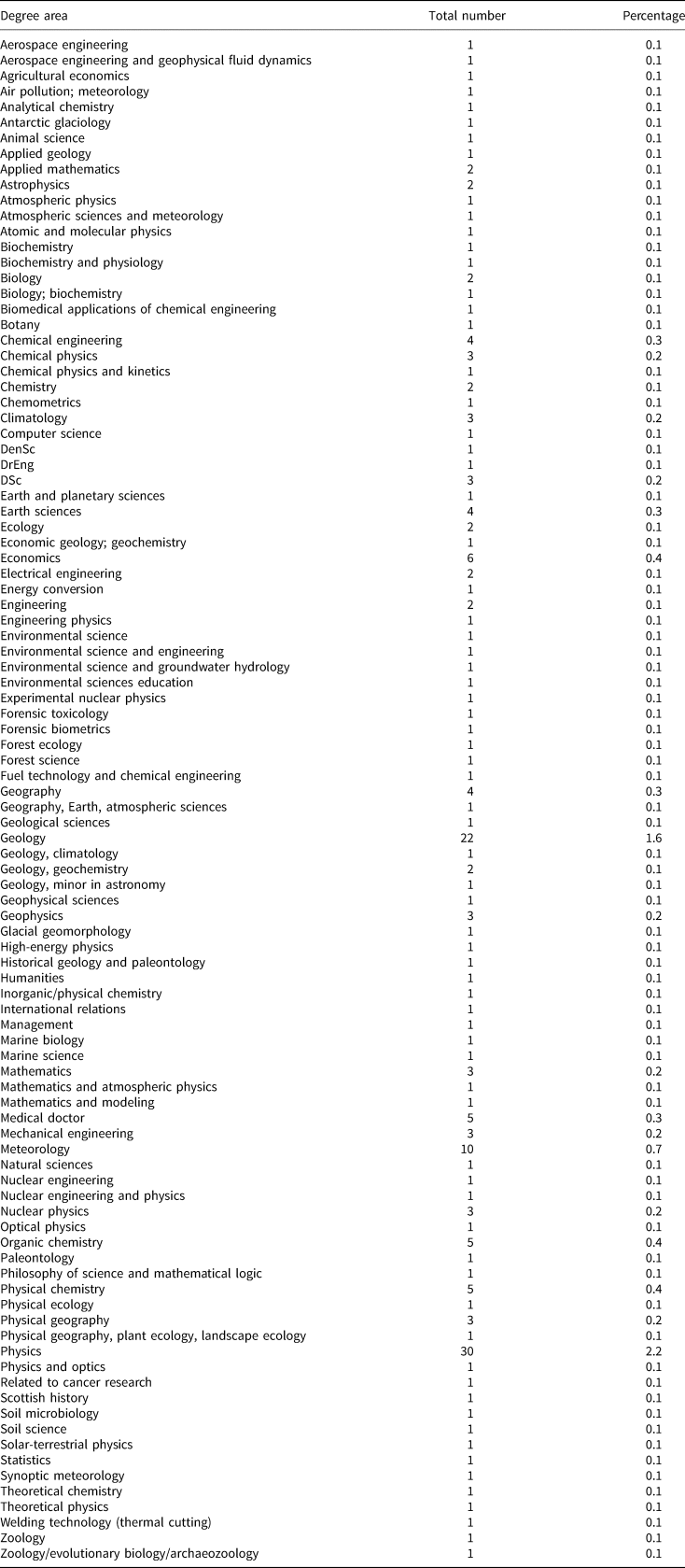
Publications
We compiled a list of 1,107 climate-related peer-reviewed articles. Of all individuals in our data, just 25 per cent published at least one climate-related peer-reviewed article. The most common journals to appear in our sample were Geophysical Research Letters, Energy & Environment, and Journal of Geophysical Research. Together, these journals account for 16 per cent of articles overall.
Fourteen individuals (3 per cent) meet expert criteria of having published twenty or more climate-related peer-reviewed articles. Collectively, this group authored 65 per cent of articles in our sample. These findings suggest: (1) most contrarians are non-experts in the realm of climate science; (2) the 3 per cent of expert contrarians produce most peer-reviewed articles on climate; and (3) the experts in our sample still represent the 3 per cent—even within a cohort made up entirely of those with contrarian views.
Among all articles included in our sample, 30 per cent were from journals that previously published abstracts that implicitly or explicitly rejected AGW.Footnote 8 Of these articles, 69 per cent were published by contrarian experts. While evaluating these journals is beyond the scope of this article, Table 5 shows not only the number of articles published in these journals by contrarians (overall and by experts) in our sample, but also the range of journals that published these authors.
Table 5. Articles published in rejection abstract journals
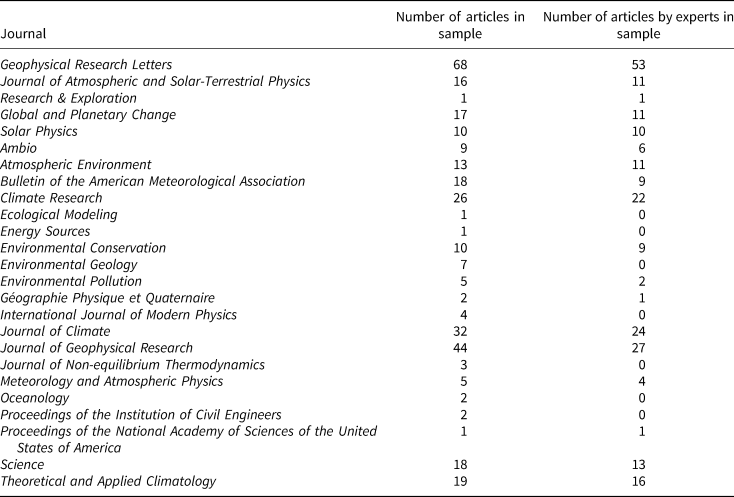
Another 9 per cent of articles in our overall sample (of which experts authored 45 per cent) were from known “contrarian” journals (Benestad Reference Benestad2013; Benestad et al. Reference Benestad2016; Kinne Reference Kinne2003; Wagner Reference Wagner2011). Energy & Environment, for example, has long been known as a publication friendly to climate science contrarians. In fact, it provided 131 of the “more than 900+ papers that supported climate change scepticism,” including one (included in our dataset) by Willie Soon and Sallie Baliunas (Hope Reference Hope2018, para. 3; see also Soon and Baliunas Reference Soon and Baliunas2003). A shorter version of their paper, published in Climate Research just months prior, had already faced significant criticism—including from the journal's then-editor in chief, who ultimately resigned in protest over the controversy (Ward Reference Ward2015, para. 6).Footnote 9 Despite these criticisms, the authors expanded on the article and published it in Energy & Environment, spearheaded by then-Editor in Chief Sonja Boehmer-Christiansen (yet another prominent contrarian in our sample). SAGE Publishing took over the journal in 2018 and has since “overhauled its peer review practices bringing it into line with SAGE standards” (Hope Reference Hope2018, para. 2). Not surprisingly, however, all articles in our sample from Energy & Environment were published prior to the end of Boehmer-Christiansen's editorship.
Remote Sensing, which experienced a similar controversy following publication of a contrarian paper, also appears in our dataset (Spencer and Braswell Reference Spencer and Braswell2011). Roy Spencer, co-author of the contentious paper, appears in our sample and meets expert criteria. Another journal, Pattern Recognition in Physics (PRP), ceased operation following publication of a contrarian article (Scafetta Reference Scafetta2013). The paper's author, Nicola Scafetta, as well as PRP's then Co-editor in Chief Nils-Axel Mörner, both appear in our sample and meet expert criteria (PRP, 2014) (see Table 6).
Table 6. Articles published in “contrarian” journals

We also found significant overlap between individuals in our dataset and authors of other contrarian publications. Among previously identified authors of flawed AGW-rejection papers, 42 per cent were found in our data; five of these individuals meet expert criteria.Footnote 10 Among previously identified authors of contrarian books, 22 per cent were found in our data; six of these individuals meet expert criteria.Footnote 11
Table 7 shows authors of the aforementioned publications who appeared in our sample. We also note who meets climate expert criteria. Collectively, these publications illustrate one way a small, yet prominent, cohort works to expand the contrarian movement through the guise of academic research.
Table 7. Authors of contrarian publications
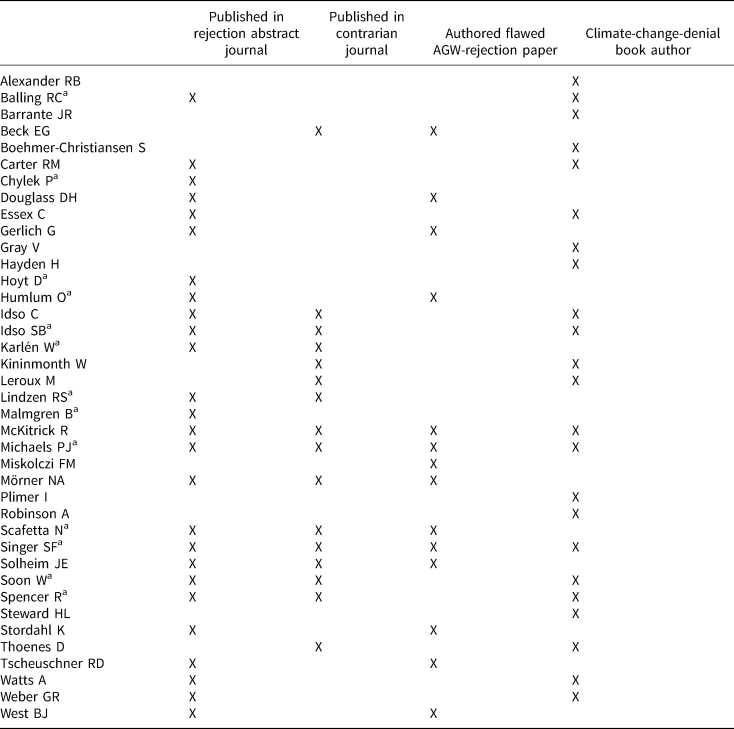
Note: a Climate science expert.
Affiliations
A total of 82 per cent of all individuals in our dataset, including 100 per cent of individuals deemed climate experts, have affiliations with industries and/or organizations involved in the CCCM (Björnberg et al. Reference Björnberg2017; Brulle Reference Brulle2014; Dunlap and Jacques Reference Dunlap and Jacques2013; McCright and Dunlap Reference McCright and Dunlap2011a; McCright et al. Reference McCright2016; Oreskes and Conway Reference Oreskes and Conway2010; Plehwe Reference Plehwe2014). Of the 82 per cent, we found: (1) 69 per cent have affiliation(s) with conservative think tanks, conservative religious groups, and/or organized causes dedicated to the rejection of the climate consensus; (2) 11 per cent have affiliation(s) with both think tanks/groups/causes and CCCM-related industries (for example, fossil fuel, mining, and utility companies); and (3) another 2 per cent have affiliation(s) just with CCCM-related industries.
Table 8 shows the number of affiliations with CCCM organizations that appeared in our data. Table 9 shows industry affiliations. Each corporation/company appeared just once, with the exceptions of ExxonMobil (seven), Peabody (four), Shell (four), and Western Fuels Association (three). Evaluating these companies/corporations is beyond the scope of this article; however, like other demographic information and affiliations, these affiliations may provide insight into contrarians' background and views.
Table 8. Organization affiliations
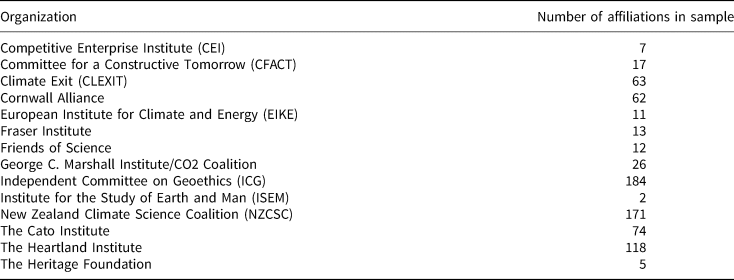
Table 9. Industry affiliations
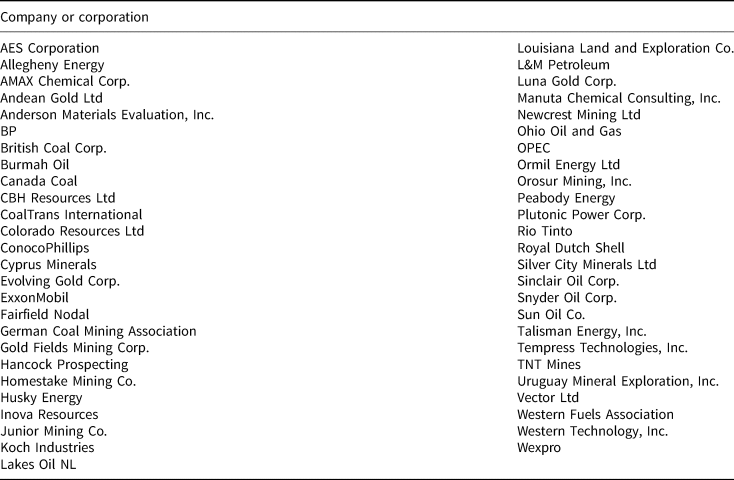
Individuals in the sample also represent a variety of other areas, many of which magnify contrarian efforts. The overlap of government, industry, conservative groups, and proponents of the free market—especially prevalent within the United States, UK, and Australia—is evidenced by five contrarians in the dataset who ran for office or serve(d) as government officials while working on behalf of the industries and ideological groups that funded them (Beder Reference Beder2001; McKewon Reference McKewon2012). Others include medical doctors, chief executive officers (CEOs) of conservative companies, film producers, and bloggers, most of whom are tied to a variety of CCCM organizations. Several other CCCM organizations shown in Table 10 also appear in our dataset but were not included as variables.Footnote 12
Table 10. CCCM organizations
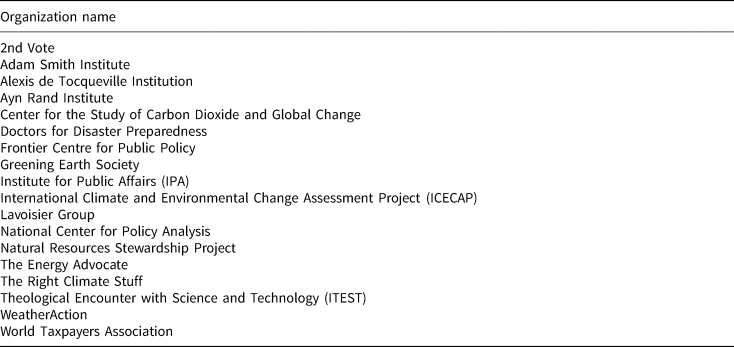
While we found no apparent affiliations for the remaining 18 per cent of signees, some individuals of the group presented other commonalities with each other and others in the sample. For example, of the five documents we analyzed, this entire subset of individuals only signed the Lindzen Petition. Eight individuals have a background in nuclear energy. Three authored papers for contrarian or rejection-abstract journals; one served on the editorial advisory board for Energy & Environment. The findings suggest that experts and non-experts alike subscribe to the same efforts, as well as the same industries and organizations, which promote contrarian views.
Collectively, our findings show that the majority of those who signed documents that reject AGW are not climate experts. As a result, these individuals lack the authority to render an opinion regarding climate change science. Our results also show that 3 per cent of expert contrarians continuously pervade multiple realms that reject AGW. We found both groups affiliated with industries and organizations of the CCCM. Expert and non-expert publications infiltrate the climate research realm, especially since most anti-consensus papers remain widely available. Contrarian books are often not subject to peer review and are widely accessible; yet, both papers and books are regularly cited despite being refuted by much of the scientific community. Others, including scientists with non-climate backgrounds, individuals who work in media, and politicians, support contrarian efforts. Together, this group can magnify arguments that reject the climate change consensus and, as a result, keep the debate on the climate consensus alive.
Discussion
What motivates experts and non-experts alike to pursue a position on climate change contrary to scientific consensus? The role of conservative politics, conservative think tanks, and industry efforts that make up the CCCM is well documented; however, our findings reveal other similarities among contrarians worthy of consideration.
In particular, the data reveal that most individuals in our data are aged sixty-five or older. This age group, at least in the United States, is also the most likely age group to disagree with the climate consensus; conversely, 80 per cent of expert Earth scientists who agree with the consensus on AGW are under the age of sixty-five (Pew Research Center 2015). Although many individuals in our sample were non-experts, the experts were also aged 65 or older on average, with an average birth year of 1944. While we expect contrarian experts to hold views different from most of the scientific community, this age distinction suggests there may be other reasons that led these individuals to align with contrarian efforts. Individuals' experiences, for example, may impact their views of science and government. As a result, this may help explain why both experts and non-experts alike participate in a movement that hinders climate change mitigation efforts.
Behavioral research suggests that experiences during individuals' formative years (that is, teens and twenties) are the most important; collective memory association determines how individuals may apply past experiences to later behavior (Goffman Reference Goffman1974; Gongaware Reference Gongaware2011; Mannheim Reference Mannheim and Kecskemeti1952 [1928]; Schuman and Scott Reference Schuman and Scott1989). In theory, the memories of contrarians aged sixty-five and older would, then, have been defined by events of the 1950s, 1960s and 1970s. This period not only marked significant changes to the study of science, as well as the rise in scientific and technological advances, but also saw an increase in institutional deceit (Atkin and House Reference Atkin and House1981; Miller Reference Miller1983; Piller Reference Piller1991).Footnote 13 Relative to events of this period, trust in government declined among the US public in the mid-1960s; trust in science also declined, particularly among conservatives, in the 1970s (Gauchat Reference Gauchat2012; Pew Research Center 2020). Relative to contrarians in our data, these events happened during the time when most received their degrees.
While one might assume that many contrarians in our sample would have higher trust in science because of their scientific degrees, prior research has found this not necessarily to be the case. Specifically, while higher education has a “positive” effect on the views of climate change for Democrats/liberals, educational attainment has a “weaker or negative” effect on the views of Republicans/conservatives (McCright and Dunlap Reference McCright and Dunlap2011a, 175, emphasis in original). As a result, and considering the conservative nature of contrarian efforts, we believe this period may have led to unique views on government and science—specifically, government intervention into scientific matters. In other words, despite older contrarians' scientific knowledge and/or education, their subjective concern about government intervention in science may surpass objectivity regarding mainstream consensus, especially considering the pervasiveness of neoliberalism during this period.
Neoliberalism emerged as a driving force to oppose government oversight and regulation, largely related to backlash from Franklin D. Roosevelt's New Deal policies and subsequent expansion of the federal government. While tenets of neoliberalism (that is, a laissez-faire approach to the market with a heavy emphasis on deregulation and free trade) would become central to CCCM objectives, the ideology pervaded academic circles far earlier (McCright and Dunlap Reference McCright and Dunlap2011a; Oreskes and Conway Reference Oreskes and Conway2010). In fact, while the ideology is most notably associated with the creation of the Chicago School of economics, it was not unique to just Chicago. Neoliberalism was transnational in nature, permeating into other academic and political circles with the help of several institutions established solely to push this ideology (Mirowski and Plehwe Reference Mirowski and Plehwe2009). As a result, by the 1950s, there was “an all-out assault on virtually every aspect of Keynesian economics” led, most notably, by Milton Friedman (Yergin and Stanislaw Reference Yergin, Stanislaw, Yergin and Stanislaw1998, para. 8). By the 1960s and 1970s, neoliberalism was a prominent theory within economics and other disciplines. As a result, much like collective memories pertinent to older contrarians' formative years, it is reasonable to believe that neoliberal ideology would have impacted contrarians' attitudes toward science and government prior to the emergence of the CCCM.Footnote 14
The CCCM materialized in 1989 in opposition to the creation of the Intergovernmental Panel on Climate Change (IPCC) (Antonio and Brulle Reference Antonio and Brulle2011). Throughout the 1990s, “conservative foundations, think tanks, and leaders mobilized to challenge the legitimacy of [climate change] problems and thus undercut the need for government action to deal with them” (McCright et al. Reference McCright2014, 252; see also Jacques et al. Reference Jacques2008). Corporate foundations (for example, ExxonMobil and Koch), in particular, continuously use free-market ideology to work against the mainstream climate consensus (Brulle Reference Brulle2014). This is not surprising considering the fossil fuel industry knew of climate change as early as the 1970s and have worked to disparage the findings of legitimate climate science ever since (Hall Reference Hall2015; Oreskes and Conway Reference Oreskes and Conway2010).
The CCCM pushes neoliberal ideology using a variety of tactics (Brulle Reference Brulle2014). Notably, and consistent with our findings, these organizations organize marketing campaigns that focus on the production of academic publications that present research biased toward the neoliberal agenda. Specifically, these publications are “tailored to specific audiences,” reconfirming the trans-academic nature of the ideological push (Mirowski and Plehwe Reference Mirowski and Plehwe2009, 6). Financial support, provided both directly to researchers and to institutions via think tanks, also flow to academics pushing research slanted toward neoliberal ideas (Mirowski and Plehwe Reference Mirowski and Plehwe2009). Funding to universities in exchange for substantial say in curricula and hiring practices, such as in the case of Koch, is another way in which these organizations seek to influence youth and, subsequently, future politicians (Carrk Reference Carrk2011; Center for Public Integrity 2018). As previously mentioned, policy makers use these experts’ and non-experts' publications and official positions to justify inaction and confuse the public when it comes to climate change. Collectively, this evidence suggests a concerted effort to create a new way of thinking ingrained in academia and shrouded under the guise of legitimate academic discourse.
The CCCM still uses these tactics today, and as a result, the academic consensus on climate change must compete with a well-crafted machine meant to confuse science and sway the political rhetoric in its favor. Unfortunately, we believe, rhetoric aligned with older individuals' existing collective memories of science and government may be dually influential in inhibiting progress on policy and with the public. As a result, while there is no doubt the CCCM successfully employs and targets a broad variety of individuals, other commonalities among many contrarians, such as age, suggest that we need further research to understand these connections.
Conclusion
Climate change is a serious issue that will impact generations to come. Although a gateway belief exists as to the causes and consequences of climate change, there are still those individuals that seek to sow doubt as to the scientific validity of these findings. Our findings suggest the 3 per cent create and circulate misinformation through a web of influence from organizations and industries tied to the CCCM. From bloggers and film producers, to older meteorologists and legitimate climate scientists, these individuals (as well as the entities with which they are affiliated) hold a vested interest in preventing climate change mitigation efforts.
Conservative think tanks, corporations, and others have spent decades challenging the mainstream consensus that fossil fuels are the main contributor to global warming—despite Exxon confirming over forty years ago through its own research that the mainstream consensus on climate change is actually correct. Moreover, industry's influence is also concerning. Not only have foundations long engaged in funding higher education institutions, but they have also had a hand in hiring the professors, and thus shaping the curriculum, that promotes their political agenda.
Perhaps one of the most interesting findings to come from this research is the cohesion among climate change contrarians when it comes to their age and the period in which their degrees were obtained. Although there are some individuals who are younger in age and/or were educated later, it is clear that a majority of contrarians are from a particular era. In addition, closer examination finds that distrust in both science and the government were growing at the same time that neoliberalism was gaining in prominence—not just as an economic theory, but because of a concerted effort to shape the political narrative regarding government involvement in the market. As a result, neoliberal thinking prevailed during most climate change contrarians' formative years. Among experts and non-experts alike, individuals who subscribed to tenets of neoliberalism during their formative years, we hypothesize, are now dedicated to efforts that push a laissez-faire approach. As a result, they may reject a mainstream consensus on issues like climate change even when most evidence points otherwise.
In her closing line given at the World Economic Forum in Switzerland in 2019, Greta Thunberg declared, “[I] want you to act. I want you to behave like our house is on fire. Because it is” (Workman Reference Workman2019, para. 7). Unfortunately, her message has remained largely unheeded, with climate change contrarians turning their attention to target her personally in addition to the science she presents (Waldman Reference Waldman2019). As a result, even with renewed calls to act, it is unlikely contrarians will go away. Regardless, if the data in this article is correct, we should expect to see the scientific consensus on climate change increase, especially since most contrarians are aging out of academic and policy circles. Action on climate change cannot wait until this occurs, however, and there must be more emphasis on distinguishing between the consensus among 97 per cent of scientists and the rhetoric spread by the 3 per cent of contrarians. As a result, and as other evidence has shown, amplifying this mainstream climate consensus and exposing the ties among think tanks, businesses, interest groups, and certain politicians, among others, especially in the United States, will help to delegitimize contrarian efforts and keep the public informed of the realities of climate change.
Data Availability Statement
The data, replication instructions, and the data's codebook are available in Harvard Dataverse at: https://doi.org/10.7910/DVN/LOO1QN.
Financial Support
The authors received no financial support for this work.













